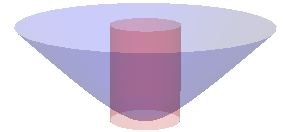After writing the previous post, I realized that there is an exact analogue of the Archimedes’ principle for the surface area of the hyperbolic disk inside the hyperbolic plane.

Archimedes (287 – 212 BC)
Let us fix the notations. Let
equipped with the Lorentzian metric .
Fix and define the hyperbolic plane
by
equipped with the induced metric.

Hyperbolic plane
It can be shown that is a surface with constant curvature
(analogous to the fact that the sphere of radius
,
, is a surface with constant curvature
). It is easy to see that
can be parametrized by
the “polar coordinates” around , with
being the (geodesic) distance from
.
Finally, let the (infinite) cylinder of radius
be defined by
again equipped with the induced metric.

Cylinder
There is a natural orthogonal projection from
to
defined by

The natural projection
In polar coordintes, this is given by
We claim that the map is area-preserving. If this is true, then we can easily calculate the area of the hyperbolic geodesic disk (with radius
)
because the projection of is exactly the finite cylinder
whose area is easy to be calculated. Indeed, the area of the cylinder is exactly the same as the ordinary cylinder in the Euclidean space .

A geodesic disk inside the hyperbolic plane
Now, it is easy to see that in the coordinates , the area form of
is given by
On the other hand, the area form of the cylinder is given by
From (1) and (3), we see that (note that )
Comparing with (2), we conclude that , i.e.
is area-preserving. As a corollary, we get
Corollary 1 The area of is
